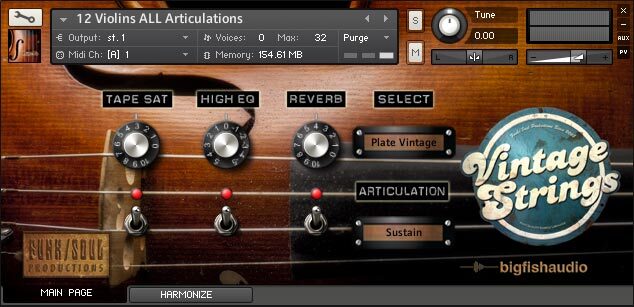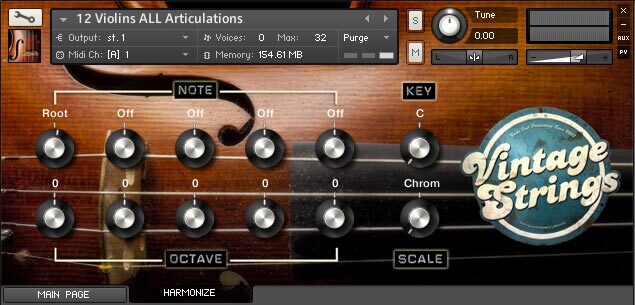- sale
- top rated

A Pure '60s and '70s Violin Section Virtual Instrument
Vintage Strings is a virtual instrument for Kontakt 5 designed to emulate the classic violin string section sounds of R&B, Soul, and Funk records from the 1960s and 1970s. Whether you're an experienced arranger or casual producer, Vintage Strings was designed to make it quick and easy for you to create great sounding string tracks for your productions. Like its sister product, Vintage Horns, Vintage Strings was not designed to be a shiny, perfect sounding virtual instrument. Instead, Big Fish Audio tried to capture the way string sections sounded back in the '60s and '70s; including the decidedly not classical playing style and minor imperfections that added character to those sections and made them sound so good.
For Vintage Strings, Big Fish Audio recorded a 6 piece violin section using vintage Neuman U-87 mics and Royer ribbon mics run through a great sounding SSL board. To capture a true vintage string sound, Big Fish Audio used close mics, room mics, and string section positioning based on actual session notes from old Motown and Philly Soul recording sessions. Rather than record the violins in a magnificent concert hall or some other large and resonant recording space, Big Fish Audio recorded their players in a funky old studio with a smaller, less-reverberant room that had characteristics similar to the rooms used to record classic Soul and R&B records. Using the tracks Big Fish Audio recorded in this space, tey then created three types of sections:
2 Violins
The 2VLN patches are very useful for creating the sound of smaller string sections. Even if played in 3-part harmony, these patches sound like a 6 piece section, rather than a full orchestral string section. The 2VLN patches take up a lot less sonic space in the mix and also have the advantage of sounding like the smaller types of string sections used on a lot of old Soul and R&B records, which didn't have the time or budget to record a larger section.
6 Violins
The 6VLN patches are great for recording unison (1 part) lines that emulate the sound of a true 6 violin section, which was very commonly used in many old Soul recordings. When used for 2-part harmonies or octaves these patches can be used to replicate the sound of an overdubbed 6 violin section (i.e., a faux 12 violin section), which was a very common recording technique used on many Motown recording sessions.
12 Violins
The 12VLN patches are very useful for creating unison (1 part) string lines that sound like an overdubbed 6 violin section. If you want to get a bigger sound with the size of a larger orchestral string section, without the color and character present in a large recording hall or symphonic space, use the patches for string parts in 2 or 3 part harmonies.
The result is a virtual instrument that has a sound and character that is distinctly different from orchestral based sampled string libraries. The sound of Vintage Strings is intentionally not big, rich, and glossy. It's a smaller, more intimate, and more "human" sound, which more accurately emulates the string sound on those classic old records.
Fast and Easy String Section Parts Using Pre-Set Patches
If you don't have a lot of experience writing for strings, or even if you're an experienced string-arranger on a tight deadline, Vintage Strings also offers a number of pre-programmed instrument patches that can help you quickly create great sounding string parts. These include the Tonal Harmonization Patches, which contain 2 part, 3 part, and 4 part patches for 2, 6, and 12 violins. Playing with just one finger on your keyboard you can easily write string lines in 2 parts (intervals), 3 parts (triads), or 4 parts (seventh chords). Secondly, the Tonal Harmonization patches include Fixed Chord & Interval Patches containing 2 part, 3 part, and 4 part Chord Patches, for 2, 6, and 12 violins. These patches are programmed to play a specific interval or chord according to the type of patch in 12 different keys.
The Vintage Strings GUI
The Vintage Strings graphical user interface (GUI) is very simple and easy to use. The main page of the interface includes control over tape saturation, high EQ, and reverb with 15 custom selected convolution reverbs.
The Harmonize Page
On the Harmonize page, you can choose the key and scale of the interval or chord-based preset patches, or create custom interval and chord-based patches of your own.
Features
- 5.1GB (Uncompressed).
- Kontakt Player 5 included.
- 3 group sizes: 2, 6, and 12 players.
- Recorded with the highest quality vintage outboard gear.
- 11 articulations.
- Auto harmonization feature for impressively quick arranging.
- Hand-selected IR options available for the convolution reverb.
System Requirements
Mac
- Mac OS X 10.7.x or later
- Intel Core Duo, 2GB of RAM
- 2.0 GHz processor or faster recommended and For optimum performance, Big Fish Audio recommends a 2.0GHz processor or faster.
- 5.1 GB of Free Hard Drive Space.
Windows
- Windows 7 / 8 (latest Service Pack, 32 / 64-bit)
- Intel Core Duo or AMD Athlon 64, and 2GB of RAM.
- 2.0 GHz processor or faster recommended.
- 5.1 GB of Free Hard Drive Space.
The Foundry is a third-party library, based in Native Instruments' Kontakt Engine. In general, whatever is listed on NI's Kontakt website for the current version will be the machine requirements for The Foundry. Big Fish Audio highly recommend running The Foundry on a computer with SSD drives for optimal performance.

Any references to any brands on this site/page, including reference to brands and instruments, are provided for description purposes only. For example references to instrument brands are provided to describe the sound of the instrument and/or the instrument used in the sample. Plugin Boutique do not have (nor do they claim) any association with or endorsement by these brands. Any goodwill attached to those brands rest with the brand owner. Plugin Boutique or its Suppliers do not accept any liability in relation to the content of the product or the accuracy of the description. "RHODES" is a registered trademark of Joseph A Brandstetter.




